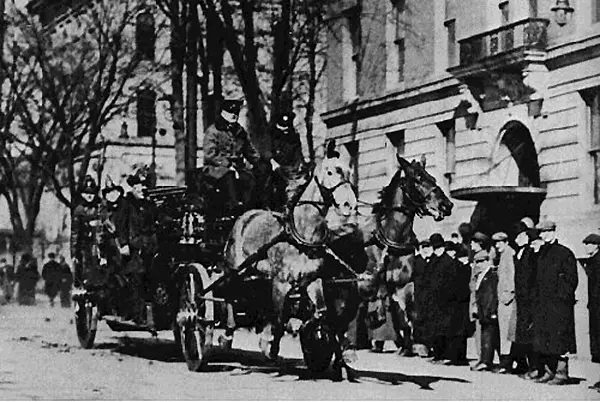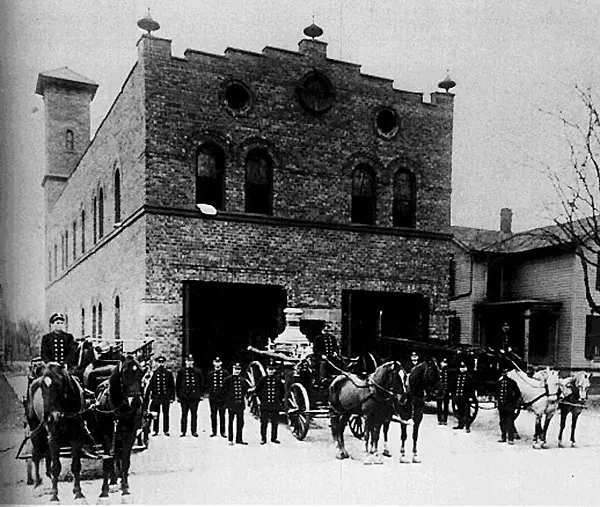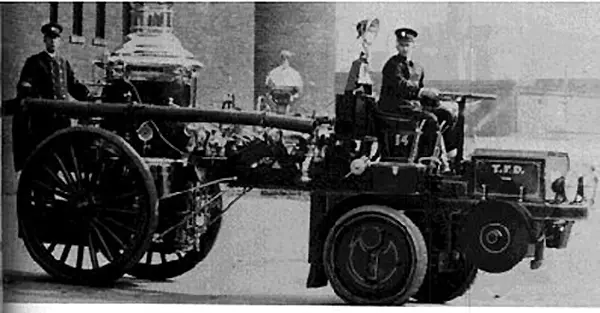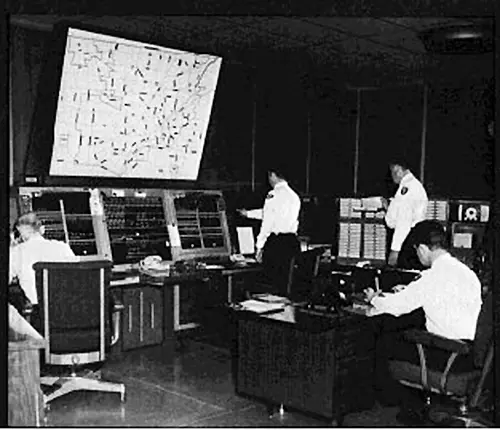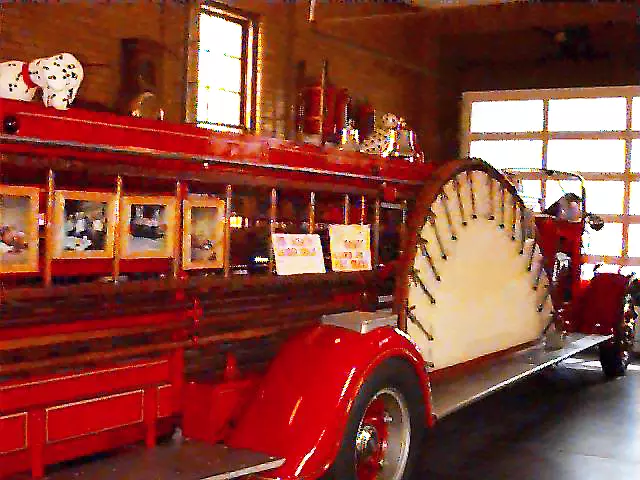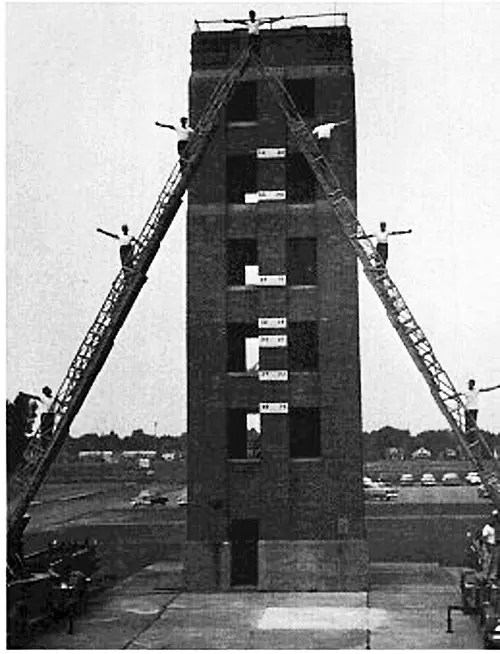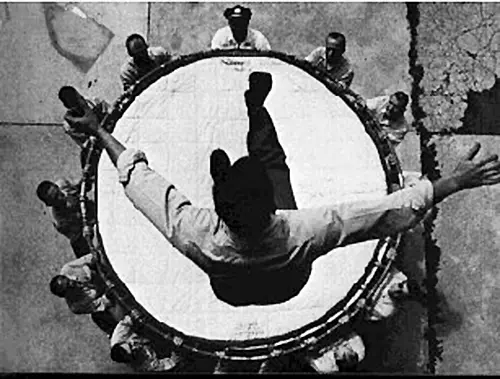Our Chronological History, 1837-1976 (from History of the Toledo Fire Division, 1837-1977 by John Killits)
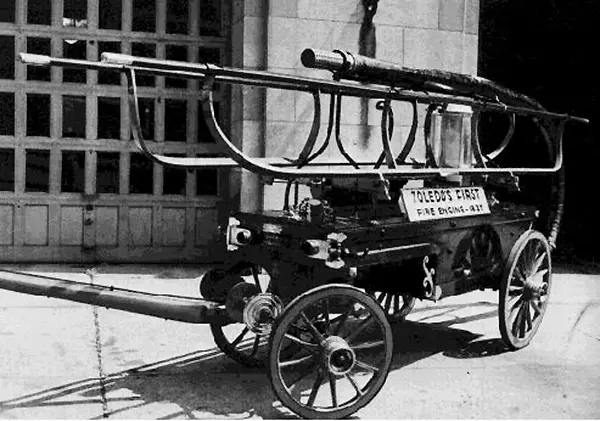 The fire engine of Neptune Fire Engine & Hose Co. No. 1
The fire engine of Neptune Fire Engine & Hose Co. No. 1
1837
City Council appointed a committee to ascertain the cost of providing two fire engines for city use.
The first effort to organize a Fire Department was by way of a resolution passed by City Council on November 27, 1837. The resolution provided that whenever a number of citizens, not less than forty, should associate themselves together for the purpose of forming a fire company, the company should be put in possession of an engine, hose-wagon, hooks and ladders, and other equipment. The companies were to be designated by numbers.
Charles McLean was elected Fire Chief of the Volunteer Fire Department. On November 27, 1837, the first Volunteer Company was organized. The first Fire Wardens were appointed on December 29, 1837.
In December of 1837, the first engine house was built on Cherry Street between Huron and Superior. It was known as Engine House No. 1. At about this time, two engines were received from a Mr. Platt on which the freight was paid amounting to $86.93.
1838
The city was divided into three wards, which remained in effect until July 2, 1848, when a fourth was established. Total cost of operation in 1838 was $45.05 plus the cost of two engines $1,909.50. Davy Crockett Fire Engine and Hose Company was formed February 3, 1838.
1840
On November 30, 1840, City Council elected officers for the Fire Department.
The first ordinance for regulating the Toledo Fire Department was passed. It provided that the Department was to consist of a Chief Engineer and such other members as should be appointed from time to time by Council; that one (1) fireman in each ward be appointed a Fire Warden, whose duties were to see that dwellings and business places were properly supplied with fire buckets; that members report for exercise; and cleaning equipment the first Monday of each month from April to October each year. (City Ord. Vol. 1, p. 47)
1842
On May 3, 1842, Council took action and built a new station on Summit, between Adams and Cherry. Franklin Fire and Hose Company formed.
1847
On September 24, 1847, Council provided for purchase of lot 161 Port Lawrence Division and the erection of an engine house not to exceed $2,500.
1851
The department consisted of two engine companies and a hook and ladder company.
It seems that there was no way of giving a general alarm of fire, as on June 14, 1851, an ordinance was passed providing that the foreman of each company should procure a key to the Episcopal Church and keep the same in the rooms of said companies. It was further provided that in case of alarm of fire, the first member of either company to arrive at the room of his company should proceed at once to the church and ring the bell until relieved by the sexton, or until the bell of the Catholic Church should be rung, and that the company whose member should first ring the bell should be paid a reward of $2.00, to be given said member upon the vote of the company. The fine for failing to ring the bell by any member who should be first on the ground was placed at $5.00, while his company forfeited all title to a reward for any service at such fire. The sexton of the Catholic Church was also liable to be a loser by this ordinance, for it stated that unless he rang the bell of that church within five minutes of the ringing of the Episcopal bell, he should forfeit the amount due him for ringing the bell during the current month. Hardest of all, it provided that the premium offered for the earliest ringing of the Episcopal bell would not be paid unless the fireman ringing the same should promptly thereafter lock the door of the church and return the key to its proper place.
1852
By the end of 1852, it is believed that there were three engine companies, known as Neptune No. 1, Erin No. 2, and Croton No. 3. 1853
On October 21, 1853, Council approved the purchase of an engine for Germania Fire Company No. 4.
1857
The department consisted of five chemical and hose companies, (two steam and three hand), one hook and ladder company, and one fire guard (Teutonia).
1858
Records show that in 1858 the department consisted of the following: Fire Co. "Erin" No. 2 - on Adams Street, west side, between St. Clair and Summit; Fire Company Hook & Ladder No. 1 - at the same location; Fire Engine and Hose Company No. 2 - disbanded; No. 3 - Monroe Street; No. 4 - Monroe St., No. 5 - St. Clair St.; No. 6 - Summit St., and one fire guard company. No street numbers are given.
1860
The records show that in 1860 the department consisted of the following: Hook and Ladder Company No. 1 - west side of Adams, between Summit and St. Clair; Engine and Hose Company No. 1 - west side of Cherry, between Superior and Huron; No. 2 - disbanded; No. 3 - west side of Monroe St., between St. Clair and Superior; No. 5 - same as No. 3; No. 6 north side of Summit, between Lagrange and Elm; No. 7 -west side of Monroe between St. Clair and Superior.
1861
It is stated that in 1861 the department consisted of, in actual service, six engine and hose companies, one Hook and Ladder Company, and one fire guard.
1863
There were recorded 22 fires with a total loss of $285,000 during this year. Of this, $225,000 was at the Michigan Southern Elevators fire. Two steam engines, three hand engines, and one Hook and Ladder Company were in use.
1866
The last year of volunteer fire service showed the following stations and apparatus in service. Station No. 1 - Lagrange and Swan Lane; No. 2 - Cherry and Eagle Lane (1st class LaFrance Engine, Muskegon Chemical Engine, and four wheel hose cart); No. 3 - Water, between Adams and Madison; No. 4 - St. Clair, between Perry and Washington; No. 5 - Broadway and Logan (1 LaFrance Engine and 1 Muskegon Hose Wagon); No. 6 - to be located in East Toledo, Starr and Main; No. 7 - Corner of Franklin and Bancroft (1 Seagrave Hook & Ladder and 1 four wheel hose carriage).
1867
Elias Avery was Chief of the Department. After Toledo became a City of the first class, Council provided for the first paid Fire Department. For each steam fire engine there was to be one (1) fireman, one (1) pipe man with full pay, and three (3) pipe men under part pay. The Chief Engineer was to hire and discharge all members by and with consent of Council.
These firemen worked ten (10) days on and one (1) off, with meal hours of one hour and twenty minutes, three times a day (a day was 24 hours). The pay scale was $700.00 a year.
A new station was being erected, and it was not quite ready for occupancy when No. 3 Company was placed on the city payroll. A building occupied by Arm’s Livery Stable was used as the engine house for several months. The new station was built on Water Street near the corner of Madison and was known as Station No. 3. It was completed in 1868.
1868
The City Directory lists the following: Steam Fire Engine House 1-99 Cherry St.; 2-89 St. Clair St.; 3 - Water, between Madison and Adams; 6-102 Lagrange St.; Relief Hook and Ladder Company, Adams opposite Trinity Church; and No. 8 – opposite First St., East Toledo.
1869
An Ordinance Council provided that the Chief Engineer be a full time employee. And, since there was no waterworks system, and because the canal was abandoned, council provided for the construction of 15 wooden cisterns in various locations for use of the Fire Department.
1870
Christ Woehier was Chief of the Department.
1872
Number 2 Fire Station was erected on Cherry Street at Eagle Lane, at a cost of $7,000. It was abandoned in 1953.
On December 15, 1872, the first fireman to be killed in action happened at a fire on Ottawa at Lafayette. A pipeman from No. 4 Company, James Welch, was killed in a fall at a fire that burned the Hall Block, and Tobacco Works. A fire at the Wilcox Co. on Water Street almost killed a whole Company, had they not emerged from the building before it collapsed.
1873
The following stations were erected: No.5 Broadway and Logan; No. 7 - Franklin and Bancroft; No. 8 - Division and Indiana; No. 1 - Lagrange and Swan Lane. Also, a temporary water works in service at Boyd’s Factory, St. Clair Street and Swan Creek, with 73 hydrants in the city.
1878
John Avery was Chief of the Fire Department. District Telegraph and Telephone Companies were organized and fire alarms were successfully received over both systems.
1884
First chemical engine introduced in department. Firemen’s Relief Association organized.
1885
John Nagely, Chief of Fire Department. No. 3 Fire Station Headquarters, Jefferson and Ontario Streets erected.
1887
An act was passed by the State Legislature creating a Board of Trustees of the Firemen’s Pension fund. First full paid fire department. Department was fully uniformed.
1889
The control of the fire department passed from council to a bipartisan commission. The legislature provided that in every city the management and control of the fire department should be vested in a Board of Fire Commissioners, composed of four members, two to be elected and two to be appointed by the Mayor, one from each political body.
First Aerial hook and ladder truck was purchased.
1890
Thomas R. Cook, Chief of the Department. Christopher F. Wall, Chief of Fire Department.
1893
No. 1 Fire Station, Bush & Erie St. erected.
No. 4 Fire Station, Monroe & Bancroft erected.
No. 9 Fire Station, Broadway & Orchard erected.
No. 10 Fire Station, Oak & Fassett erected.
The first Negro fire company was appointed to No. 11 Station on 315 Water Street on October 1, 1893. (Formerly Station No. 3)
1894
January 3, 1894, a fire which burned the King’s Elevators; the Chamber of Commerce; the
Wonderland; and several other buildings, cost the life of Fire Captain James Fraser, of Engine No. 1. Several other firemen were severely injured.
1895
A new station was erected for No. 6 Fire Station at Starr and Main Streets.
1896
Records Indicate a List of Stations and Their Apparatus as Follows:
No. 1 Located at Bush and Erie - 2nd class Ahrens Engine and 1 combination hose wagon and cart.
No. 3 Located at Jefferson near Ontario - 1 Babcock Aerial Turntable Extension Hook and Ladder, 1 Seagrave hook and ladder, 1 Muskegon Chemical Engine, and 1 Milburn Hose Wagon.
No. 4 Located at Monroe near Bancroft - 1 Clapp and Jones Engine, 1 combination hose wagon and chemical.
No. 5 Broadway and Logan - 1 Clapp and Jones Engine
No. 6 Main and Statt - 1 Silsby Engine, 1 Milburn Hose Wagon, 1 Champion Chemical Engine, and 1 Seagrave Hook and Ladder.
No. 7 Franklin and Bancroft - 1 Seagrave Hook and Ladder, and 1 four wheel hose carriage.
No. 8 Division and Indiana - 1 Ahrens Engine and 1 four wheel hose carriage.
No. 9 Broadway and Orchard - 1 Milburn combination Hose Wagon and Chemical.
No. 10 Oak and Fasset - 1 combination hose wagon and Chemical.
No. 11 315 Water near Madison - 1 Milburn hose wagon and 1 Champion Water Tower.
1899
No. 12 Fire Station, Summit & Cleveland erected.
No. 13 Fire Station, Front & Paine Ave. erected.
No. 14 Fire Station, Lagrange & Everett erected.
No. 15 Fire Station, Wayne near Gibbons erected.
Gamewell Fire Alarm System placed in service. The first fire alarm received from a street alarm Box 212 located at Broadway and Ottawa on February 20, 1899.
1900
Hours changed to six days on and one day off.
1902
William F. Mayo was Chief of Fire Department.
1903
Control of the fire department passed from the Board of Fire Commissioners to a Board of Public Safety by virtue of the new municipal code of that year.
1906
No. 16 Fire Station at Detroit & Woodland Avenues erected.
1907
Fire Department shop at John R. and Division Streets erected.
1908
No. 17 Fire Station, Detroit & Glenwood erected.
1909
Board of Public Safety abolished and department placed under Director of Public Safety.
1910
State Civil Service Law in effect and first commission was appointed.
1912
A $200,000 bond issue was approved for motorizing the department. Plans called for the selling of 100 horses to offset the bond issue.
Champion Water Tower placed into service, No. 6 station. First auto equipment (three Chief cars) placed into service.
1913
On May 17, 1913, a gas tractor was attached to an engine at No. 3 House. It reached speeds of 25 mph. The tractor was made by the Knox Tractor Co. of Springfield, Massachusetts. They sent three for free use on a trial basis. The other two went to stations No. 2 and No. 5.
1914
George Fraser, Chief of Fire Department.
First motorized fire apparatus placed in service:
1 - 85’ American LaFrance Aerial Hook & Ladder
3 - Knox-Martin 3 wheel tractors
3 - Peerless City Service Hook & Ladder Trucks
1 - Seagrave City Service Hook & Ladder Truck
1 - Peerless Combination Hose & Chemical Truck
5 - Willys Knight Chief Cars
The Charter of the City of Toledo provided that the Safety Department was to be under the jurisdiction of a Safety Director appointed by the Mayor, and the Fire Department became the Division of Fire in the Department of Public Safety.
1915
Louis H. Elling, Chief of Fire Division.
The High Pressure System was placed in and service hours changed to 4 days on, 2 days off
1916
The last horse retired from the fire service from No. 15 Station at Airline and Gibbons Streets on August 12, 1916. The Division of Fire was completely motorized.
By March 25, 1916 there were 2,250 fire hydrants, 66 of them high pressure.
1918
International Association of Firefighters chartered. Local 92, No. 3 Station (headquarters) was rebuilt on the site of the razed former station built in 1885 at Jefferson and Ontario.
1919
First motor-driven pumper purchased and first steamer replaced (November 1)
1920
Firemen began working the two-platoon system of 48 hours on duty, 48 hours off duty (Sept. 16). No.
18 Fire Station at Sylvania & Peak St. erected.
1921
No. 11 Fire Station at 315 Water St. abandoned and No. 11 Company moved to new quarters at the foot of Madison Avenue and the Maumee River.
1922
No. 19 Fire Station at Stickney & Ketcham Ave. erected.
No. 15 Fire Station at Wayne & Gibbons Street abandoned and No. 15 Company moved to present station on Fearing Blvd. near Airline Avenue.
1927
Fred J. Myers, Chief of Fire Division.
No. 1 Station rebuilt at Bush & Erie Sts.
1929
Fire Prevention Bureau created (June 1)
1930
Drill School created (September 1)
March 1st, running out of No. 5s, the last steamer was replaced by a pumper.
1931
No. 21 Fire Station at Glendale and Detroit Avenue erected.
No. 23 Fire Station at Central and Oatis Street erected, known originally as No. 22
No. 3 moved to 20 North Superior Street on March 3, 1931 (the old jail). Old No. 3 at Jefferson and Ontario abandoned.
1932
Radio broadcasting of fire alarms began (Aug. 9)
Positions of Engineers and Assistant Engineers abolished by council.
1933
On June 15, 1933, No. 11 Fire Station at the foot of
Madison Avenue was abandoned and No. 11 Hose Company moved to No. 3 Station at 20 N. Superior St. Rescue Squad placed in service (October)
1935
Firemen began working the three-platoon system: 8 hours a day, 48 hours a week (June 1). Fire Stations Nos. 12, 15, 19, and No. 23 closed; No. 11 Company, running out of No. 3s, and the Drill Tower were disbanded (June 1)
Fred T. Schlorf, Chief of Division of Fire, 1936
No. 13 and No. 18 Hook and Ladder trucks out of service (May 1)
Short wave radios installed in chief cars (May 2)
The position of Chief Inspector in the Fire Prevention Bureau created.
1936
August 1: position of Assistant Chief abolished and position of Deputy Chief created
November 1: No. 23 Fire Station reopened
1937
April 1: No. 12 Fire Station reopened
July 1: No 15 Fire Station reopened
December 1: Firemen began working 24 hours on and 48 hours off
1938
June 1: Drill Tower erected at the rear of No. 23 fire Station, Central and Qatis. Position of Drill Master created.
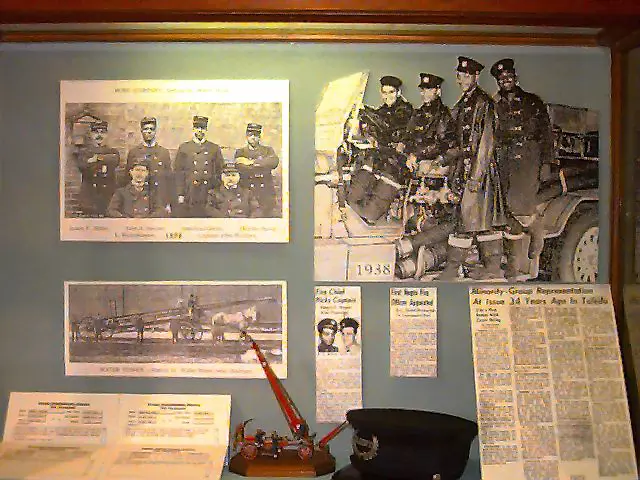 Colored fire company for No. 8 Station appointed.
Colored fire company for No. 8 Station appointed.
July 16: Colored Fire Company for No. 8 Station appointed.
August 16: No. 19 Fire Station reopened.
1939
June 16: No. 2 Hook and Ladder out of service
June 17: Colored fire company dismissed ("illegally appointed")
1940
July 16: No. 24 Fire Station at Summit and 114th Street opened through the annexation of Point Place
1941-1945
Fifty men of the Toledo Fire Divisions were drafted for Military Service and six of them were killed in the line of duty.
Many members of the Fire Division served with the Civilian Defense Corps as air raid wardens and first aid instructors during the war. Two firefighters were assigned to the chiefs cars during the war years and were called commandos.
1946
Patrick J. Daly Chief of Fire Division
1950
No. 4 Fire Station rebuilt at Monroe and Bancroft.
1951
Karl B. Scheidler Chief of Division
New No. 6 Fire Station erected at Starr and Euclid; old station abandoned (Opened March 12)
1952
Arnold F. Papenhagen Chief of Division
1953
New No. 1 Fire Station erected at Huron and Orange; old Station No. 2 and No. 3 abandoned (opened May 18); designation of original No. 1 Station changed to No. 3.
August 1: No.3, No. 16, No. 17 Ladder Companies moved to No. 12, No. 15, and No. 4, respectively; No. 7 District Chief moved to No. 17 and No. 4 District Chief moved to No. 16.
1961
May 1: No. 6 Rescue Squad placed in service at No. 6 Station
June 10: the worst day in the history of the Toledo Fire Division occurred at a gasoline truck explosion on the Anthony Wayne Trail which killed four firemen (six were seriously injured) and injured 81 civilians.
1962
January 1: Firefighters’ hours reduced to 54 hours per week.
June 10: Maumee Chemical Company explosion; 10 civilians killed, 40 civilians injured
1963
June 10: Fire Fighter memorial dedicated.
1964
March: Fire Department widow’s pension raised to $90.00 per month
March 11: No. 14 Fire Station at Lagrange and Everett Streets, closed 7:00 A.M.
March 11: No. 25 Fire Station at Central and Meadowwood opened
March 15: Fifteen new men appointed for No. 26 Fire Station; division strength increased from 487 men to 502
March 17: No. 26 Fire Station opened at Airport and Byrne; station obtained from Adams Township by annexation
December: Fire Prevention Code adopted by City Council and added to the Toledo Municipal Code
December 28: No. 14 Fire Station opened. This station was obtained from Adams Township by annexation. It was formerly known as Adams Township No. 1, located at Reynolds and Hess. Fifteen new men were appointed for No. 14 Fire Station; strength increased to 517
1965
January 25: No. 23 Fire Station located at Central and Oatis closed at 7:00 A.M. and relocated at Trilby Volunteer Station at Secor Road near Alexis, by annexation of Washington Township.
Clothing allowance increased to $100.00 per year.
No. 19 Station located at Stickney and Ketcham was closed and relocated at the new station on Stickney opposite the Kaiser plant.
1966
March 1: fifteen privates were promoted to Lieutenants to serve as relief officers.
March 11: No. 23 Company moved to their new quarters at Laskey and Goodwill at 7:00 a.m. and the old volunteer station on Secor closed.
$5000.00 group life insurance program started; clothing allowance increased to $150.00 annually and a $325.00 flat raise granted.
November: 1/2 Penny for Progress Levy passed by voters, enabling City Council to appropriate funds for the replacement of four Fire Stations; officers appointed for ladder trucks.
1967
January 2: authorized strength increased to 541 men
No. 5 Rescue Squad placed in service at No. 25
July 21: thirty new firemen appointed; strength increased to 571 men
The new position of Administrative Deputy Chief was created and a new district created
July: riots hit Toledo; one firefighter killed, many injured; record number of alarms answered
September 13: new No. 11 Fire Station opened located on Airport and Seymour. Old No. 26 Station located on S. Byrne and Airport to be used by the Fire Prevention Bureau
December 26: New No. 12 Station opened on Suder near Manhattan Boulevard; old No. 12 Station located on Summit at Cleveland closed and turned over to the Division of Parks
1968
Fire Division placed on 52-hour work week.
March: Toledo’s first fireboat, the "Ewald Bode," placed in service
April 17: No. 5 Station at Broadway and Logan closed; new No. 5 Station at Ontario and Washington opened with #5 Pumper, #8 Pumper, and #5 Ladder; No. 8 Fire Station closed.
July 1: Chief A. F. Papenhagen retired
July 4: Chief Eulan G. Tucker appointed Chief
August: Fire Department Shop moved from Indiana and Division to the Municipal Garage on Albion Street. Position of water officer established.
1969
March 26: No. 2 pumper put out of service, men reassigned; No. 8 pumper put out of service, men reassigned
April 1: Two-man emergency units placed in service at No. 6, 15, 23, 24, and 25 Fire Stations
June 1; eight new pumpers ordered for Fire Division. Deputy Chiefs placed in charge of four bureaus:
No.1 Training and Maintenance
No.2 Fire Prevention
No.3 Communication and Special Services
No.4 Fire Extinguishment and Rescue
July 1: Radiological Monitoring Unit established with fifteen members
October 31: No. 7 Fire Station rebuilt at Franklin and Bancroft
1970
June 11, 1970: No. 4 Fire Station at Monroe and Bancroft closed; building turned over to Board of Community Relations
1971
July 1: new No. 4 Fire Station at 3940 Hill Avenue opened. No. 12 ladder out of service; tactical units in service
1972
October: year-round program on fire safety in the Toledo Schools with Fireman Freddy started
1973
April 19: first woman applied to become city firefighter
April 20: Fire Training Center opened at Toledo Express Airport
August 7: Fire Division acquired two amphibious Larks from the United States Government
1974
April 29, 1974: civilian employee, confidential secretary to the chief appointed
1975
January 1: seven mini-size pumpers (scats) placed in service
February 7: Firefighters went on an 8 hour day, three shifts, forty-hour work week
May 7: Tiedtke’s Department Store burned at Summit and Adams Streets
May 5: two emergency Life Squads placed in service
Old No. 18 Fire Station at Sylvania and Peak Avenues closed; new No. 18 at 5225 Lewis Avenue opened
November 7: Voters passed charter amendment allowing Council to regulate firefighter hours
1976
February 6, 1976: maintenance shop moved to Wall Street Armory
March 4: Firefighters end eight hour shift, forty-hour week and return to a 24 hours on, 48 hours off, 52- hour work week
March 5: twelve firefighters laid off, reducing strength to 554
April 17: Chief Eulan G. Tucker retired
April 18: Deputy Chief Raymond G. Seelman named Acting Chief
May 1: third Life Squad placed in service Fire Station at No.18
October 15: Carl W. Neeb appointed as Chief of the Fire Division
November: Firefighters work week reduced to 50 hours, effective 1-1-77
December 1, 1976: New Training Facility opened across from the Toledo Express Airport

